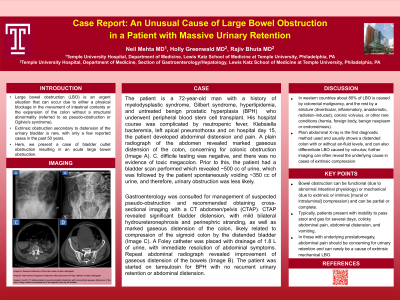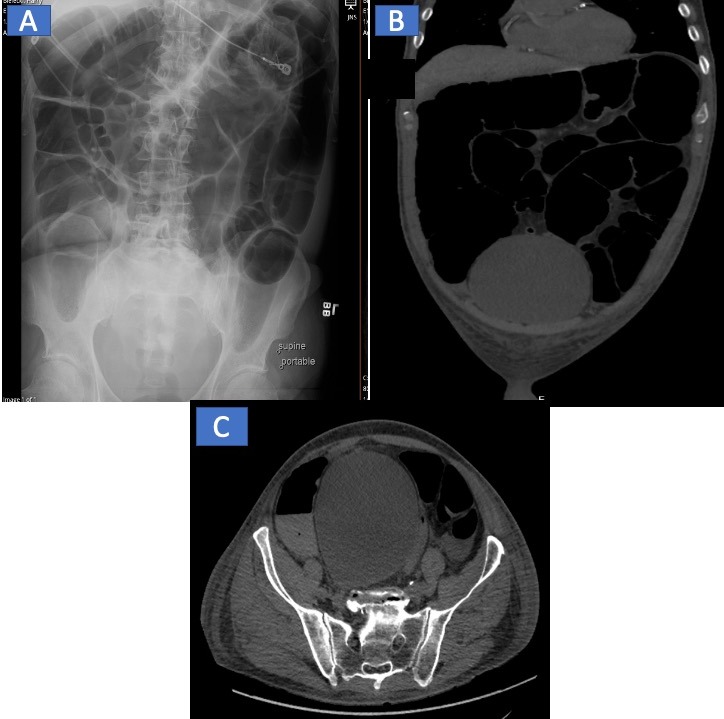Tuesday Poster Session
Category: Colon
P3068 - An Unusual Cause of Large Bowel Obstruction in a Patient With Massive Urinary Retention
Tuesday, October 24, 2023
10:30 AM - 4:00 PM PT
Location: Exhibit Hall

Has Audio

Neil Mehta, MD
Temple University Hospital
Philadelphia, PA
Presenting Author(s)
Neil Mehta, MD, Holly Greenwald, MD, Rajiv Bhuta, MD
Temple University Hospital, Philadelphia, PA
Introduction: Large bowel obstruction (LBO) is an urgent situation that can occur due to either a physical blockage in the movement of intestinal contents or the expansion of the colon without a structural abnormality (referred to as pseudo-obstruction or Ogilvie's syndrome). Extrinsic obstruction secondary to distension of the urinary bladder is rare, with only a few reported cases in the past 50 years. Here, we present a case of bladder outlet obstruction resulting in an acute large bowel obstruction.
Case Description/Methods: The patient is a 72-year-old man with a history of myelodysplastic syndrome, Gilbert syndrome, hyperlipidemia, and untreated benign prostatic hyperplasia (BPH) who underwent peripheral blood stem cell transplant. His hospital course was complicated by neutropenic fever, Klebsiella bacteremia, left apical pneumothorax and on hospital day 15, the patient developed abdominal distension and pain. A plain radiograph of the abdomen revealed marked gaseous distension of the colon, concerning for colonic obstruction (Image A). C. difficile testing was negative, and there was no evidence of toxic megacolon. Prior to this, the patient had a bladder scan performed which revealed ~500 cc of urine, which was followed by the patient spontaneously voiding ~350 cc of urine, and therefore, urinary obstruction was less likely. Gastroenterology was consulted for management of suspected pseudo-obstruction and recommended obtaining cross-sectional imaging with a CT abdomen/pelvis (CTAP). CTAP revealed significant bladder distension, with mild bilateral hydroureteronephrosis and perinephric stranding, as well as marked gaseous distension of the colon, likely related to compression of the sigmoid colon by the distended bladder (Image B and Image C). A Foley catheter was placed with drainage of 1.8 L of urine, with immediate resolution of abdominal symptoms. Repeat abdominal radiograph revealed improvement of gaseous distension of the bowels. The patient was started on tamsulosin for BPH with no recurrent urinary retention or abdominal distension.
Discussion: Bowel obstruction can be functional (due to abnormal intestinal physiology) or mechanical (due to extrinsic or intrinsic [mural or intraluminal] compression) and can be partial or complete. In patients with critical illness, physical obstruction should always be ruled out. In those with underlying prostatomegaly, abdominal pain should be concerning for urinary retention and can rarely be a cause of extrinsic mechanical LBO.

Disclosures:
Neil Mehta, MD, Holly Greenwald, MD, Rajiv Bhuta, MD. P3068 - An Unusual Cause of Large Bowel Obstruction in a Patient With Massive Urinary Retention, ACG 2023 Annual Scientific Meeting Abstracts. Vancouver, BC, Canada: American College of Gastroenterology.
Temple University Hospital, Philadelphia, PA
Introduction: Large bowel obstruction (LBO) is an urgent situation that can occur due to either a physical blockage in the movement of intestinal contents or the expansion of the colon without a structural abnormality (referred to as pseudo-obstruction or Ogilvie's syndrome). Extrinsic obstruction secondary to distension of the urinary bladder is rare, with only a few reported cases in the past 50 years. Here, we present a case of bladder outlet obstruction resulting in an acute large bowel obstruction.
Case Description/Methods: The patient is a 72-year-old man with a history of myelodysplastic syndrome, Gilbert syndrome, hyperlipidemia, and untreated benign prostatic hyperplasia (BPH) who underwent peripheral blood stem cell transplant. His hospital course was complicated by neutropenic fever, Klebsiella bacteremia, left apical pneumothorax and on hospital day 15, the patient developed abdominal distension and pain. A plain radiograph of the abdomen revealed marked gaseous distension of the colon, concerning for colonic obstruction (Image A). C. difficile testing was negative, and there was no evidence of toxic megacolon. Prior to this, the patient had a bladder scan performed which revealed ~500 cc of urine, which was followed by the patient spontaneously voiding ~350 cc of urine, and therefore, urinary obstruction was less likely. Gastroenterology was consulted for management of suspected pseudo-obstruction and recommended obtaining cross-sectional imaging with a CT abdomen/pelvis (CTAP). CTAP revealed significant bladder distension, with mild bilateral hydroureteronephrosis and perinephric stranding, as well as marked gaseous distension of the colon, likely related to compression of the sigmoid colon by the distended bladder (Image B and Image C). A Foley catheter was placed with drainage of 1.8 L of urine, with immediate resolution of abdominal symptoms. Repeat abdominal radiograph revealed improvement of gaseous distension of the bowels. The patient was started on tamsulosin for BPH with no recurrent urinary retention or abdominal distension.
Discussion: Bowel obstruction can be functional (due to abnormal intestinal physiology) or mechanical (due to extrinsic or intrinsic [mural or intraluminal] compression) and can be partial or complete. In patients with critical illness, physical obstruction should always be ruled out. In those with underlying prostatomegaly, abdominal pain should be concerning for urinary retention and can rarely be a cause of extrinsic mechanical LBO.

Figure: Distended bladder compressing the rectosigmoid colon causing large bowel obstruction
Disclosures:
Neil Mehta indicated no relevant financial relationships.
Holly Greenwald indicated no relevant financial relationships.
Rajiv Bhuta indicated no relevant financial relationships.
Neil Mehta, MD, Holly Greenwald, MD, Rajiv Bhuta, MD. P3068 - An Unusual Cause of Large Bowel Obstruction in a Patient With Massive Urinary Retention, ACG 2023 Annual Scientific Meeting Abstracts. Vancouver, BC, Canada: American College of Gastroenterology.
